Spreadsheet data updated daily
Top 5 List Updated on December 27th, 2022, by Nikolaos Sismanis
The communication services sector has a lot to offer investors, particularly those looking for higher investment income.
Many communication services stocks generate strong profits and cash flow, which allow them to pay high dividend yields to shareholders.
And, the major communication services stocks broadly have lower valuations than many other market sectors, making them appealing for value investors as well.
With this in mind, we created a list of communication services stocks.
You can download the list (along with important financial ratios such as dividend yields and payout ratios) by clicking on the link below:
Keep reading this article to learn more about the benefits of investing in communication services stocks.
Table Of Contents
The following table of contents provides for easy navigation:
How To Use The Communication Services Stocks List To Find Investment Ideas
Having an Excel database of all communication services stocks, combined with important investing metrics and ratios, is very useful.
This tool becomes even more powerful when combined with knowledge of how to use Microsoft Excel to find the best investment opportunities.
With that in mind, this section will provide a quick explanation of how you can instantly search for stocks with particular characteristics, using two screens as an example.
The first screen that we will implement is for stocks with price-to-earnings ratios below 15.
Screen 1: Low P/E Ratios
Step 1: Download the Communication Services Stocks Excel Spreadsheet List at the link above.
Step 2: Click the filter icon at the top of the price-to-earnings ratio column, as shown below.
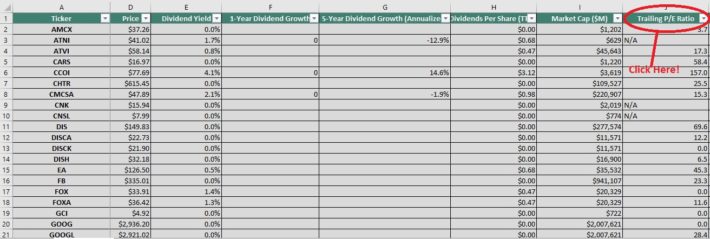
Step 3: Change the filter field to ‘Less Than’, and input ’15’ into the field beside it.
The remaining list of stocks contains stocks with price-to-earnings ratios less than 15.
The next section demonstrates how to screen for stocks with high dividend yields.
Screen 2: Communication Services Stocks With High Dividend Yields
Stocks are often categorized based on their dividend yields. This is the percentage of an investment that an investor will receive in dividend income.
We define high dividend yields as stocks with yields of 5% or more.
Screening for stocks with high dividend yields could provide interesting investment opportunities for more risk-averse, income-oriented investors.
Here’s how to use the Communication Services Stocks Excel Spreadsheet List to find such investment opportunities.
Step 1: Download the Communication Services Stocks Excel Spreadsheet List at the link above.
Step 2: Click on the filter icon for the ‘dividend yield’ column, as shown below.
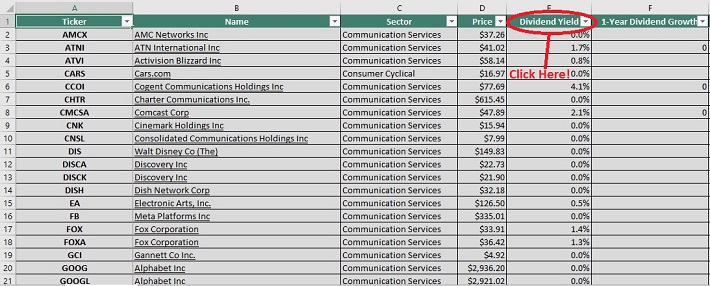
Step 3: Change the filter setting to ‘Greater Than’ and input 0.03 into the column beside it. Note that 0.03 is equivalent to 3%.
The remaining stocks in this list are those with dividend yields above 3%. This narrowed investment universe is suitable for investors looking for low-risk, high-yield securities.
You now have a solid fundamental understanding of how to use the spreadsheet to its fullest potential. The remainder of this article will discuss the top 5 communication services stocks now.
The Top 5 Communication Services Stocks Now
The following section discusses our top five communication services stocks today, based on their expected annual returns over the next five years.
The rankings in this article are derived from our expected total return estimates from the Sure Analysis Research Database.
The five stocks with the highest projected five-year total returns are ranked in this article, from lowest to highest.
Related: Watch the video below to learn how to calculate expected total return for any stock.
Rankings are compiled based upon the combination of current dividend yield, expected change in valuation, as well as expected annual earnings-per-share growth.
This determines which communication services stocks offer the best total return potential for shareholders.
#5: Comcast Corporation (CMCSA)
- 5-year expected annual return: 14.9%
Comcast is a media, entertainment and communications company. Its business units include Cable Communications (High–Speed Internet, Video, Business Services, Voice, Advertising, Wireless), NBCUniversal (Cable Networks, Theme Parks, Broadcast TV, Filmed Entertainment), and Sky, a leading entertainment company in Europe.
Comcast reported its Q3 2022 results on 10/27/22. For the quarter, the company’s revenue dropped 1.5% to $29.8 billion, adjusted EBITDA (a cash flow proxy) rose 5.9% to 9.5 billion, adjusted earnings-per-share (EPS) climbed 10.3% to $0.96, and it generated free cash flow (FCF) of $3,4 billion.
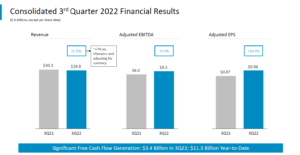
Source: Investor Presentation
Comcast has had a compelling earnings-growth history that was helped by share repurchases.
From 2012 to 2021, its EPS increased at a compound annual growth rate (CAGR) of 12.3%. The past five years saw a CAGR of 11.9%
Overall, total returns are expected to reach 14.9% per year over the next five years.
Click here to download our most recent Sure Analysis report on Comcast (preview of page 1 of 3 shown below):
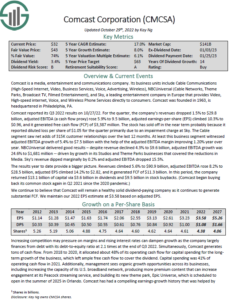
#4: Twenty-First Century Fox (FOXA)
- 5-year expected annual returns: 15.2%
Fox Corp. is a television broadcasting company with a $15.9 billion market cap.
The company, known among insiders as “New Fox,” was spun off from the former 21st Century Fox when The Walt Disney Co. (DIS) acquired most of its assets in 2019, including its cinema entertainment business.
Since the spinoff, Fox Corp. has been a much more focused company, with its operations centered on cable networks and television. For the fiscal year (FY) 2022, the company generated $13.97 billion in revenue.
On November 1st, 2022, Fox Corp. reported first-quarter results for fiscal year (FY) 2023. The company’s fiscal year ends at the end of July. The company reported revenue of $3.19 billion, a 5% increase from the $3.05 billion reported in the prior year’s quarter.
The company made $1.21 per share during the quarter, beating estimates by $0.09. We expect that Fox Corp will earn $3.52 per share for FY2023. This will represent an increase of 26% compared to FY 2022.
We expect annual returns of 15.2% per year, due to 5% EPS growth, the 1.6% dividend yield, and a ~8.7% annual return from a rising P/E multiple.
Click here to download our most recent Sure Analysis report on Twenty-First Century Fox (preview of page 1 of 3 shown below):
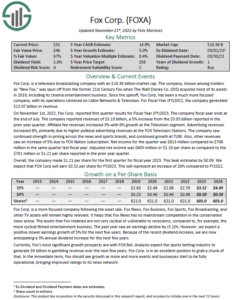
#3: Verizon Communications (VZ)
- 5-year expected annual returns: 17.1%
Verizon Communications was created by a merger between Bell Atlantic Corp and GTE Corp in June 2000. Verizon is one of the largest wireless carriers in the country.
Wireless contributes three–quarters of all revenue, and broadband and cable services account for about a quarter of sales. The company’s network covers ~300 million people and 98% of the U.S.
Verizon has now launched 5G Ultra–Wideband in several cities as it continues its rollout of 5G service. Customers in parts of Atlanta, Dallas, Detroit, Indianapolis, Omaha and Washington, D.C. were able to access the company’s 5G network.
Verizon stock trades for a 2022 P/E ratio below 7.3, compared with our fair value estimate of 11. Shareholder returns are expected to be boosted by a rising valuation multiple, expected EPS growth of 4%, and the high dividend yield of 6.9%.
Overall, total returns are expected to reach 17.1% per year over the next five years.
Click here to download our most recent Sure Analysis report on Verizon (preview of page 1 of 3 shown below):
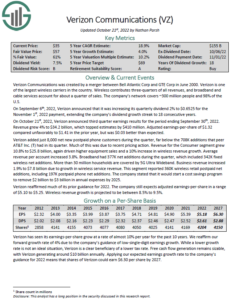
#2: Telephone & Data Systems (TDS)
- 5-year expected annual returns: 17.7%
Telephone & Data Systems is a telecommunications company that provides customers with cellular and landline services, wireless products, cable, broadband, and voice services across the United States.
The company’s Cellular Division accounts for more than 75% of total operating revenue. TDS started in 1969 as a collection of 10 rural telephone companies. Today the company has a market cap of $1.3 billion and more than $5.3 billion in annual revenue.
On November 3rd, TDS reported financial results for the third quarter of 2022. The company’s total operating revenue was $1.4 billion, up 5% compared to the same period one year ago. Net income was $(25) million, down from last year’s $28 million. Diluted earnings per share of $(0.22) also compared unfavorably to the $0.24 earned one year ago.
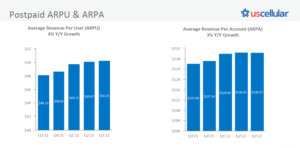
Source: Investor Presentation
TDS has raised its dividend for 48 consecutive years (TDS is currently a Dividend Aristocrat). It has grown its dividend by 3% per year on average over the past five years.
Due to the volatility in the company’s earnings history, we believe that the best way to assess the valuation of TDS is by looking at its price-to-book ratio. TDS is currently trading at a price-to-book ratio of 0.24, which is much lower than its 10-year average of 0.67. If the stock reverts closer to its average valuation level over the next five years (at a P/B of 0.45), it will enjoy a 17.7% annualized gain.
Click here to download our most recent Sure Analysis report on TDS (preview of page 1 of 3 shown below):
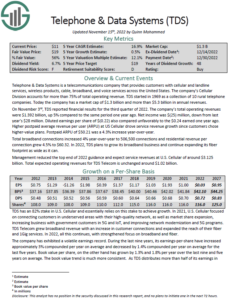
#1: Orange SA (ORAN)
Orange is one of the world’s leading telecommunications operators headquartered in Paris, France. The company was incorporated in 1996 as France Telecom and changed its name to Orange SA in 2013.
The group operates in 26 countries and employs more than 147,000 people worldwide. The company provides a range of fixed and mobile telecommunications, data transmission, and other value-added services to consumers, businesses, and other telecommunications operators in Europe, Africa, and the Middle East.
Orange SA is listed on Euronet Paris (symbol: ORA) and the NYSE (Symbol: ORAN) and is classified into five reportable business segments: France, Europe, Africa & Middle East, Enterprise, and International Carriers & Shared Services. The company trades with a $26.1 billion market capitalization.
Orange released Q3 2022 results on October 25th, 2022, where the company posted a year-over-year revenue gain of just 1% compared to Q3 2021. Revenue was driven by sales in Africa & the Middle East, which grew by 4.2%. Europe is slowly improving thanks to Spain returning to growth. France is also showing signs of recovery as sales increased by 1.9%
Click here to download our most recent Sure Analysis report on Orange SA (preview of page 1 of 3 shown below):
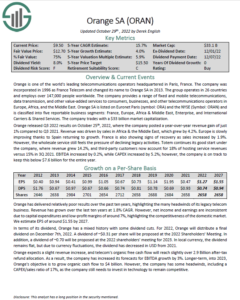
Orange has shown sound cash flow generation over the last five years, and leadership expects to grow cash flow to $4 billion by 2023.
We have estimated a return of 18.2% annually through 2027 based on a 4% earnings growth estimate, an 13% dividend yield, and a valuation tailwind potential.
Final Thoughts
The communication services sector is attractive for long-term investment. Demand for various communication services such as Internet and wireless remains high, and is not likely to slow down any time soon.
The sector is also appealing for income investors, due to the high-yielding telecom giants such as Telephone and Data Systems and Verizon.
If you’re willing to explore ideas outside of the communication services sector, the following databases contain some of the most high-quality dividend stocks around:
- The Dividend Aristocrats: dividend stocks with 25+ years of consecutive dividend increases.
- The Dividend Achievers: dividend stocks with 10+ years of consecutive dividend increases.
- The Dividend Kings: Considered the best-of-the-best when it comes to dividend history, the Dividend Kings are an elite group of dividend stocks with 50+ years of consecutive dividend increases.
- The Blue Chip Stocks List: dividend stocks that are on the Dividend Achievers, Dividend Aristocrats, and/or Dividend Kings list.
If you’re looking for other sector-specific stocks, the following Sure Dividend databases will be useful:
Thanks for reading this article. Please send any feedback, corrections, or questions to [email protected].













